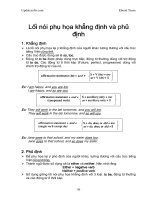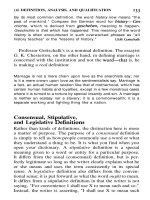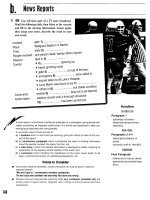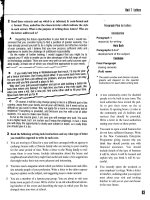Learning Express visual Writing PHẦN 4 ppsx
Bạn đang xem bản rút gọn của tài liệu. Xem và tải ngay bản đầy đủ của tài liệu tại đây (144.09 KB, 14 trang )
PIZZA ACTIVITY #2 NARRATIVE:
Write a story about a teenage boy who ate a whole pizza.
visual writing and cereal
35
PIZZA ACTIVITY #3 INFORMATIVE:
Use any resources available to you
(including the Web or books) to write a speech that
explains why pizza provides a nutritionally sound meal.
visual writing
36
PIZZA ACTIVITY #4 PERSUASIVE:
Your science teacher has asked the class to determine
which meal contains more nutritional value—two slices of
pizza, or turkey on whole wheat. Using what you know
about these foods, convince your teacher that your
answer is correct.
visual writing and cereal
37
make the connection to
your writing
sharpening your organizational skills
Before continuing your exploration of
Visual Writing, complete the activities
below to reinforce your understanding of
the value of visual writing. The more you
practice graphic organizing in a non-threat-
ening environment—wherever you are right
now—the more you will be able to com-
fortably and confidently call upon your skills
when your environment is a little more
threatening: the essay testing room!
1. Create a visual map that graphically organizes all aspects of a zoo.
2. Think about the following essay topics, each of them concerning zoos:
a. Describe the day in the life of a particular animal living at the zoo.
b. Share your fondest or worst experience related to a visit to the zoo.
c. Prepare a speech for your school’s foreign exchange students who
will be touring your local zoo. Use what you know about your
local zoo or zoos in general to explain to them what they can
expect from their visit.
d.Many people believe that zoos provide a wonderful opportunity
to see and experience animals they would otherwise never see.
Animal rights activists contend that zoos are inhumane. Write an
essay that expresses your viewpoint.
3. Now that you have read each of the topics above, consider the following:
a. Is my map about zoos thorough enough to answer one or more of
the prompts above or are there more details I must add so that I
might respond to, or address, these essay questions?
visual writing
38
b. Are some details relevant to one essay prompt but not the others?
c. What other graphic organizers might I construct that would be
more useful to addressing particular prompts? (Example: a plot dia-
gram for Essay B.)
4. Define or explain each of the graphic organizers listed below and the
types of essays for which they are best suited. (You may want to con-
struct a visual map to answer this question . . . Hint, hint.) You can
write your answers on page 40.
■ Hierarchical map
■ Venn Diagram
■ Sequential Chart
■ Cyclical Map
■ Wo rd Web
■ Plot Diagram
5. What is the purpose of a follow-up braintalk? You can write your
answers on page 40.
When you finish this section, you’ll be ready to learn about 1-2-3
maps!
visual writing and cereal
39
visual writing
40
by now you understand visual maps,
the many varieties you can create, and
their usefulness during those nail-biting,
heart-stopping moments when you
must face essay tests.
But how does a visual map translate
into prose on the essay, the fancy word
for ordinary writing otherwise known
as sentences and paragraphs? How do
you transform Venn or plot diagrams,
word maps, etc., into the introductory,
body, and concluding paragraphs
required of essays? It’s as easy as one,
two, three.
1-2-3 maps
41
four
1-2-3 Maps:
Using Visual Maps
toWrite Essays
chapter
putting it all together
In Chapter Three you constructed a variety of visual maps based on essay
prompts all related to cereal, so you should have proven to yourself that you
and your brain really know how to pick things apart. If so, you are ready to
learn how your already-prepared visual maps become the middle sections of
1-2-3 maps.
1-2-3 maps organize your 1) introductory, 2) body, and 3) concluding
paragraphs. Whether you write one or one
hundred paragraphs, an essay must have an
introduction, a body of supporting details,
and a conclusion.
The 1-2-3 map graphically separates each
of these important sections, reminding you
of their order.
Let’s consider the filtering system that
saved the Apollo 13 astronauts again, only
now we will relate it to the 1-2-3 map. The objective of the Apollo 13 engi-
neers was to build a filtering system that would ensure safe air
for the endangered astronauts. The engineers meeting
their objective depended on three sections: a box, a
cylinder, and a hose in the middle that would ulti-
mately connect them. Though the parts were
very distinct, their connection was critical to the
success of that objective. Each essay you write has
an objective, too. Determined by your essay
prompt, that objective relies on three sections: an
introduction, a conclusion, and a body of support in
the middle that ultimately connects them. Like the air fil-
ter parts, the connection of the three sections is very critical to the quality,
and therefore success, of your essay.
visual writing
42
Remember: Whether you write
one or one hundred paragraphs,
an essay must have an introduc-
tion, a body of supporting de-
tails, and a conclusion.
The first and last shapes of your 1-2-3 map compare to the Apollo 13 box and cylinder,
and the middle part, your graphic organizer, is word widgets and gadgets that connect
those parts!
1-2-3 maps—breathing life into your essays
Let’s use the Venn diagram constructed in Chapter Three, which contrasted
the differences between cereal and bacon and eggs for breakfast. Sure, the
Venn diagram clearly separated the information necessary to respond to the
essay prompt that asked the writer to choose between breakfasts, but now
what? Where do you begin? And begin is what you must do to write an essay!
the 1-2-3 plan
N
O MATTER HOW many pages you take to write an essay, each page and
each paragraph is connected to the other. The connecting sections can be
summed up in several different sets of three words: beginning, middle, end;
start, middle, finish; introduction, body, conclusion: 1-2-3.
So, where do you find the first part of your essay in Venn or plot diagrams,
or cyclical maps? You don’t—not unless you construct and complete the
graphic organizer appropriate for each essay, as part of a 1-2-3 map. The
1-2-3 map borrows shapes used by the Apollo 13 engineers for their air fil-
ter solution. The box and cylinder fit our 1-2-3 map objective perfectly.
constructing a 1-2-3 map for an essay
1. At the top of your paper, draw a small box and write key words that
identify the essay’s objective, topic, purpose, etc.
2. At the bottom, draw a small cylinder in which you write the same words
that were written in the box.
3. In the middle, construct and complete the graphic organizer appropri-
ate to the essay objective, then draw a circle (the hose!) around it, con-
necting your middle to the top and bottom.
There you have it! The organization for your opening, middle, and clos-
ing paragraphs. Let’s take a look at how a 1-2-3 Map connects all the parts
of a well-constructed essay.
1-2-3 maps
43
a visual on the 1-2-3 map
visual writing
44
2
write your objective here
too, so you remember to
restate it in your conclusion.
construct the graphic
organizer that best suits your essay
prompt in this space. The connecting
hose encircles the supporting details
that your visual map generates. The
hose encircling these details reminds
you to connect your graphic organizer
with opening and closing paragraphs,
which identify your essay’s
objective.
1
write your essay’s objective
here in your opening.
3
follow-up braintalks
After setting up your 1-2-3 map, you will want to conduct a follow-up
braintalk, mentioned in Chapter Three. Whether mental or written, the fol-
low-up directs your brain to sequence or reorganize your middle map’s words
and phrases so that you can effectively apply your 1-2-3 map’s contents to
well-written paragraphs.
Follow-Up Braintalk: I need to work on my middle map so my essay runs smoothly—from
start to finish!
the 1-2-3 map and follow-up braintalk
cereal essay # 1
YOU WILL NOTICE a few additions to the original map in Chapter Three,
which compared cereal to bacon and egg breakfasts: the box and cylinder.
You see the objective of the essay
twice, once in the box and once again
in the cylinder shape, reminding the
writer that effective essays always state
and restate an essay’s purpose in both
the introductory and concluding para-
graphs.
The shapes, borrowed from the
Apollo 13 shapes, are connected to one
another by, in this case, a Venn diagram.
The diagram contains the details that
distinguish the two breakfasts. The hose
is drawn to remind you that the middle part, which becomes the body para-
graphs, must connect your beginning to your ending. The more you prac-
tice the 1-2-3 map, the less need you have to actually draw the connectors.
As you examine this 1-2-3 map, read the follow-up braintalk carefully and
pay attention to the additions that were made to the original Venn diagram.
You will read the essay generated by the map shortly.
1-2-3 maps
45
The hose is drawn to remind you that
the middle part, which becomes the
body paragraphs, must connect your
beginning to your ending. The more
you practice the 1-2-3 Map, the sub-
tler your connectors can be.
making connections to your writing
How is the box like an introductory paragraph?
How is the visual map encircled by a hose like body paragraphs?
How is the cylinder like a concluding paragraph?
venn diagram 1-2-3 map
Recall: Cereal Essay #1: You are asked to choose your club’s end-of-
year breakfast meeting menu: cereal or bacon and eggs? Convince
your fellow members that your choice of breakfast is the best
choice.
visual writing
46
You will find the answers to the questions in this chapter. Now let’s have a
look at the essays about cereal. When you notice that the 1-2-3 map designs
and shapes differ, remember: artistic creativity is permissible!
1-2-3 maps
47
from 1-2-3 maps to essays
Cereal Essay Prompt #1: You are asked to decide the menu for your
club’s end-of-year breakfast meeting: cereal or bacon and eggs?
Convince your fellow members that your choice of breakfast is the
best choice. (Persuasion)
venn diagram student sample
(Notice how the concepts in the Venn diagram on the previous page appear in the essay.)
Cholesterol. Fat. Two bad, bad, words in our health-conscious
society. How can anyone think that a bacon and eggs breakfast
would be the choice to make for our club’s last meeting? Sure,
everyone needs the energy they get from breakfast, and bacon and
eggs is a breakfast meal. But is it a good one? NO! Cereal, on the
other hand, is a good meal and my choice for our end-of-year
breakfast meeting.
First of all, you always pour milk on cereal so that means calci-
um. And calcium means strong bones. And if you’re wondering,
2% fat milk has just as much calcium as whole milk with hardly any
fat so we should use 2%. If strong bones are important to you then
so are muscles, especially if you want to look buff. Since milk is a
protein food it will be good for your muscles.
As for the cereal part of a cereal and milk breakfast, it is usual-
ly no fat or low fat. Sure, cereal will keep you thin, but that’s not
the reason we should serve it at our breakfast. The real reason is
carbohydrates, which give us energy—energy to keep up with
school, sports, and more.
visual writing
48
Follow-up Braintalk: Okay, I think cereal is the best choice, so I put that in my open-
ing and closing. I wrote a lot of facts in my Venn diagram. Now what? My opening should
grab attention. I’ll open
with the “fat” and “bad” stuff. I’ll put all the good stuff about cere-
al in the middle
and I’ll end with how bacon and eggs might smell and t
aste
good
, but
they’re bad for you. Being breakfast foods is the only thing they have in common. I’ll use
that in my opening and closing.









